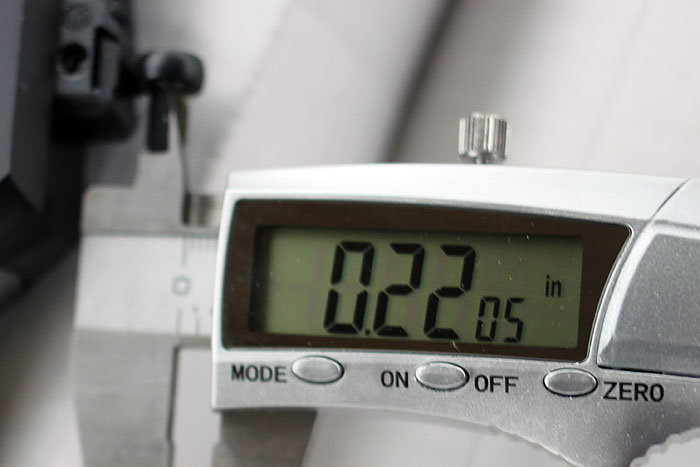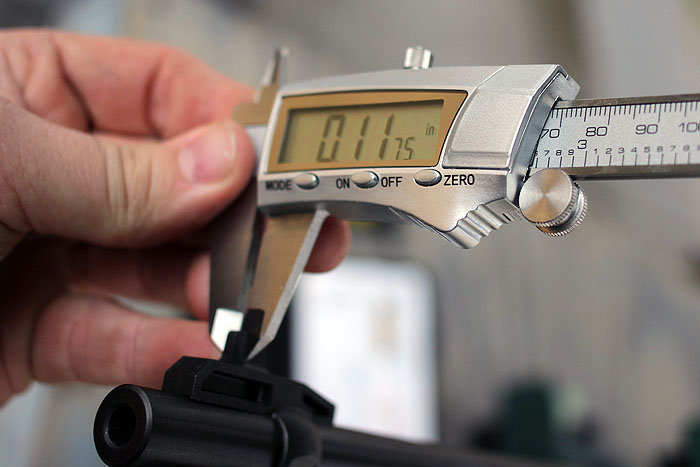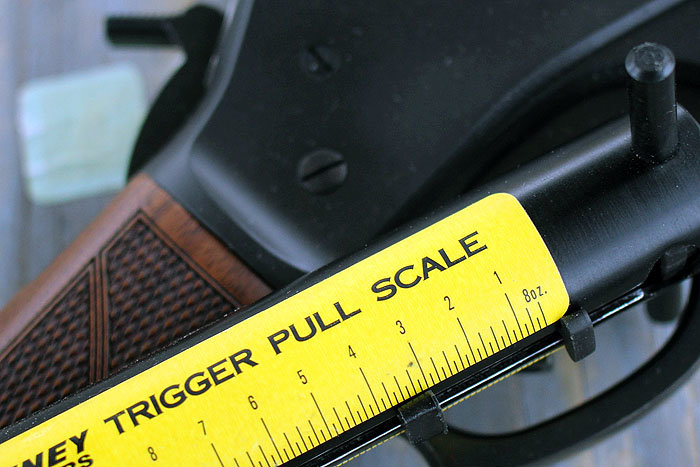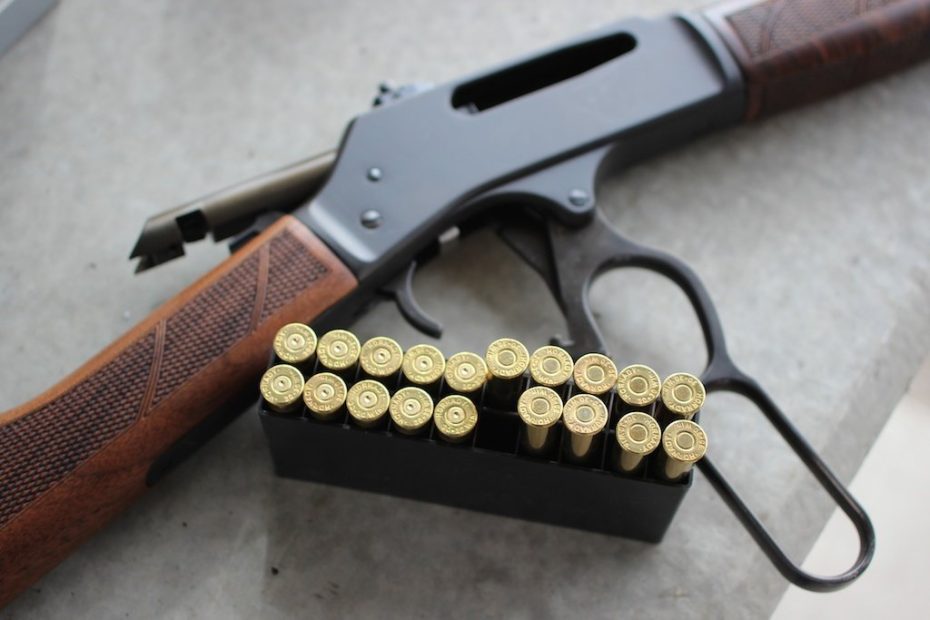[one_half padding=”0 0 0 0px”]
[track-link url=”https://www.henryrifles.com/henry-rifles/” campaign=”Henry Rifles” target=”_blank”]
Henry Rifles
[/track-link]
[/one_half]
[one_half_last padding=”0 0 0 0px”]
[track-link url=”/Search.htm?T=Henry+45-70″ campaign=”Henry Rifles” target=”_blank”]![]() [/track-link]
[/track-link]
[/one_half_last]

Henry Repeating Arms takes its name from the inventor of the first reliable repeating rifle, Benjamin Tyler Henry. That took place back in 1860—when most rifles were still loaded from the muzzle end. In 1996 the Henry name was revived and the brass framed lever guns were once again available. Made in America, too. That’s a big point of pride for Henry.
Most of the offerings from Henry have been in line with the guns designed by their namesake—pistol caliber lever actions. These guns make versatile ranch guns, and are popular with the weekend cowboys who pop steel bad guys. I have a deep respect for lever guns in pistol calibers, but there are times that you need more. Henry has an answer for that now with two new lever actions. They now have a rifle in the classic deer hunting .30-30 and one in the old hard hitting favorite, 45-70. Lever actions, yes, but miles away from the pistol calibers you might associate with the brand.
There are a couple of things that make a Henry a Henry. One is the side ejection found on all models, excluding the reproduction of the original Henry design (the one from the 1860s). The other is the way they load. All of the Henrys load from the muzzle end of the tubular magazine. A spring loaded brass tube that rides inside the magazine keeps the rounds in place and pushed to the rear for feeding. This is a take on the way the original Henry loaded. This is not the more common loading gate on the side of the receiver that Winchester and Marlin use. Using the loading tube sometimes takes a little work and getting used to. You have to wiggle it around and twist as you push it closed to clear the rounds.

Made in the USA
Before we get into the meat of this review on the two Henrys, I want to take a few words to talk about the Made in The USA aspect of the brand. Winchesters are not made in the States any longer. Call me patriotic, but I just feel there is something inherently wrong with a Japanese made version of “The Gun That Won The West.” The American West that is, not West Tokyo.
If you are one who tracks trends in the firearms industry, pay attention to patriotism. My bet is that “Made in America” is about to become wildly fashionable. Henry isn’t going to remind you they make their guns in the states—it has been such a core part of the company’s identify. If you want a newly manufactured American made lever action rifle, Henry is on your short list. But there is more to them that just being made in The States—they are solid and reliable firearms.
[one_half padding=”0 0 0 0px”]
[track-link url=”https://www.henryrifles.com/rifles/the-henry-3030/” campaign=”Henry Rifles” target=”_blank”]
Henry .30-30
[/track-link]
[/one_half]
[one_half_last padding=”0 0 0 0px”]
[track-link url=”/Search.htm?T=Henry+30-30″ campaign=”Henry Rifles” target=”_blank”]![]() [/track-link]
[/track-link]
[/one_half_last]

[one_half]
| .30/30 Steel with Round Barrel | |
|---|---|
| Model Number | H009 |
| Action Type | Lever Action |
| Caliber | .30-30 |
| Capacity | 5 rounds |
| Length | 39″ |
| Barrel Length | 20″ |
| Weight | 7 lbs. |
| Stock | Deluxe checkered American walnut, rubber buttpad |
| Sights | XS Ghost Rings sights |
| Features | Sling swivels |
| M.S.R.P. | $749.95 |
| .30/30 Brass with Octagon Barrel | |
| Model Number | H009B |
| Weight | 8.3 lbs. |
| Stock | Straight-grip American Walnut, buttplate |
| M.S.R.P. | $950.00 |
[/one_half]
[one_half_last]

[/one_half_last]
Lets start with the smaller of the two Henrys. These come in two different set ups. There is a version that has the classic brass frame and octagon barrel and, like the review gun, a steel frame with round barrel. Everything else on the two is about the same. They sport a 20 inch barrel, weigh in around 7 pounds, and hold 5 rounds. The American Walnut stock on both is straight and the steel framed version adds some well done checkering. The MSRP on the steel frame is $750 and the brass is $950.

Fit and Finish
These are nice looking rifles. I am a sucker for blued steel and walnut. Are these the prettiest and most blemish free guns I have ever seen? No. But they are well in line for the price point. They are a lot nicer than an el-cheapo imported rifle. On the 30-30 there are a couple of small tool marks here and there. The magazine tube is not over polished and there are a couple of places on the stock that have some filler. Those are the negatives and they are far outweighed by the positives. The finish on the barrel and the receiver is a glossy and deep black. The receiver comes in the box wrapped in a protective cloth sock. This simple little sock shows me that Henry takes pride in their work and wants to help insure it gets to the customer as it left the factory, which isn’t always easy when it is bouncing around between distributors and dealers.
The action is pretty slick out of the box and got smoother the more it was cycled. This is not as smooth as a tricked out Cowboy action lever gun, but this is not meant for competition. Far from it. The .30-30 Henry is not an approved caliber for SASS shooting. This is a working gun. Don’t let its looks fool you–this is a gun that wants to ride around in the truck, or in a handlebar rack on an ATV. Like a good dog, this gun needs to work.
Sights
The Henry ships with XS Ghost Ring sights. The ones that were on the review guns were large. I mean huge. The rear ghost ring on the .30-30 measured .19″ inside the ring. The one on the .45-70 was even larger: .22″. They were so big that I emailed Henry to make sure there wasn’t a mix up. I was told that they used this ring on the first batch of rifles but had since changed to a smaller size. They shipped me the newer smaller ones and said they would do the same for anyone that has the big ones.
[one_half]

[/one_half][one_half_last]

[/one_half_last]
The front sight is also large. It is built onto the barrel band. The blade is wide. The wide sight, combined with the large ghost ring feels more appropriate for the type of close range shooting the cowboys do. With the new narrow ring installed, the combination becomes more usable.
Either way, it is an interesting sight set up. The ghost rings are incredibly fast. Throw the gun to your shoulder and point and you’re likely in the ring and on target, at least at close ranges. If you are hunting and need to fine tune a shot at 100 yards or more, it is possible. I didn’t find the sight pair as easy to use as some other styles, but it is functional, and I would suspect that I’d get used to the sights in time.
[one_half]

[/one_half][one_half_last]

[/one_half_last]

Shooting
The first trip to the range with the .30-30 wasn’t stellar, as I was having trouble adjusting to the sights. At 50 yards it was hard to shoot a group that was under 3 inches. With a good bit of practice, I began shooting closer to what I’d percieved as point of aim, and the groups tightened up to under 2 inches at 100 yards.
I am sure that the rifle is capable of a lot tighter groups. There’s another review to be written still about adding a scope to both of these guns. They are tapped for scope mounts if you should chose to go that route. It isn’t out of the question for me, but I’ve always thought of lever guns as brush guns. They need to be able to reach out past 150 yards, sure, but most of their work will be done at close quarters. I flushed a whitetail this weekend, for example, and I was carrying a .308 with a 3-9 scoped dialed in at 9. I saw the deer at the same time that he saw me, and he bolted. He was too damn close. If I’d had the Henry, I’d have dropped him where he stood. My mistake. This is a .30-30, not a target rifle. I’ll put a scope on it soon, and see what it is capable of with good glass–but for now, I was more interested in what it would do all by itself.
We ran Hornady LEVERevelution 160 Grain through the Henry, along with a random smattering of extras we had (including a couple of boxes of Winchesters). All worked predictably well. There are so many varieties of .30-30 available, and almost every sporting goods store and big-box retailer in the country should have a decent selection. It is a capable round–not as hot as the .308 or .30-06, but capable.

Over the course of at least 4 range trips and a couple of hundred rounds, I experienced zero failures with the Henry .30-30. Of course that is one of the great things about a lever action; there isn’t a whole heck of a lot to go wrong. Loading is as reliable as any old pump shotgun. Extraction is reliable and consistent. What could go wrong? The .30-30 doesn’t like to be loaded while the rifle is pointed straight up, but even then it still loads. It is just more difficult. There’s the outside possibility of a round failing, though the strength and weight of the hammer helps insure there won’t be any light primer strikes.
And that’s why this platform continues to remain relevant. The gun is capable under ridiculous conditions. As long as you are still functioning, it will function. It is the height of mid 19th century tactical design updated to early 20th century ballistic standards, and it fills a big American made hole in the contemporary lever action market.
[one_half padding=”0 0 0 0px”]
[track-link url=”https://www.henryrifles.com/rifles/45-70-lever-action/” campaign=”Henry Rifles” target=”_blank”]
Henry .45-70
[/track-link]
[/one_half]
[one_half_last padding=”0 0 0 0px”]
[track-link url=”/Search.htm?T=Henry+45-70″ campaign=”Henry Rifles” target=”_blank”]![]() [/track-link]
[/track-link]
[/one_half_last]

[one_half]

[/one_half][one_half_last]
.45-70 Lever Action |
|
|---|---|
| Model Number | H010 |
| Action Type | Lever Action |
| Caliber | .45-70 |
| Capacity | 4 rounds |
| Length | 39″ |
| Barrel Length | 18.43″ |
| Weight | 7.08 lbs. |
| Stock | Pistol-grip American walnut with buttplate |
| Sights | XS Ghost Rings rear sight with blade front |
| M.S.R.P. | $850.00 |
[/one_half_last]

But let’s say you’re not on board with the .30-30. You want something more. There aren’t a whole lot of calibers more American than the big .45-70. Put it in a good lever gun with a slice of your mom’s apple pie and shoot it on the 4th of July while Anyong in his Uncle Sam costume reads the Declaration of Independence. As Henry says, “Made in America or not made at all.” In my opinion, the .45-70 is the big game cartridge for North America. There is nothing on four legs on this continent that the .45-70 cannot handle. There might be a better choice if you want to take some very long range shots, but for typical hunting and defense, it is hard to beat.
Aside from being straight up ‘Merica, the Henry .45-70 is a slick rifle. It comes with an 18.5 inch barrel, pistol grip walnut stock and weighs right at 7 pounds. Like the .30-30 they also come with the ghost ring sights. This one came with the huge ring as well and Henry supplied us with the smaller ones at our request.

Fit and Finish
I could almost copy and paste the paragraph about the .30-30 into this spot. These are well fitted and finished rifles. Not the level of hand fitting and polish you would see on a Holland and Holland, but very nicely done. The wood on the pistol grip stock on the .45-70 has some nice figure in the grain and is a bit fancier than on the .30-30.
I called the .30-30 a working gun above and I stand by that for the .45-70 as well. Both of these would make great truck guns–once you get past putting that first nick or scratch on them. I wouldn’t call them bottom-of-the-boat guns; they are too nice for that. But with some honest-to-God wear from being carried in the brush and tucked behind the seat of your old Chevy, these guns will look the part of a true working gun.

Shooting
There is just something that I love about shooting a .45-70. Although the recoil can be a bit fatiguing, this is a fun shooting rifle. It feels good to throw a 325 grain bullet close to 2000 fps down range. It usually puts a grin on my face. Unless I didn’t have the butt pulled in tight.
We were able to get consistent 2 inch groups with the 325 grain Hornady LEVERevelution rounds at 100 yards. When you consider the intent of the .45-70 (a round that was once used to hunt buffalo), I think that’s functional accuracy. Look at the circle on the target to the right. Imagine that circle superimposed over the heart of an elk. 325 grains of lead moving close to 2,000 FPS?!
The Henry would make a great brush gun for Rocky Mountain hunts, if you weren’t planning on really reaching out to impractical distances.

Final Thoughts
These are two very capable rifles in two of the must iconic American hunting calibers. If you are looking for a great white tail hunting rifle you could do a lot worse than the Henry .30-30. Need a rifle for the bigger game? The .45-70 will do the trick. It would also make a great bear country defense rifle as well. My only complaint is the fiddling it takes to get the magazine tube in when loading. But that is one of the things that make a Henry and Henry and it is far from a deal breaker.
And these are guns you’ll keep forever. They’re heirlooms that will instill pride and confidence, and the wear on the wood and steel will invoke stories.
[one_half]

[/one_half][one_half_last]

[/one_half_last]
[one_half]

[/one_half][one_half_last]

[/one_half_last]
[one_half]

[/one_half][one_half_last]

[/one_half_last]
[one_half]

[/one_half][one_half_last]

[/one_half_last]
[one_half]

[/one_half][one_half_last]

[/one_half_last]
[one_half]

[/one_half][one_half_last]

[/one_half_last]
[one_half]

[/one_half][one_half_last]

[/one_half_last]
[one_half]

[/one_half][one_half_last]

[/one_half_last]
[one_half]

[/one_half][one_half_last]

[/one_half_last]
[one_half]

[/one_half][one_half_last]

[/one_half_last]
[one_half]

[/one_half][one_half_last]

[/one_half_last]
[one_half]

[/one_half][one_half_last][/one_half_last]
